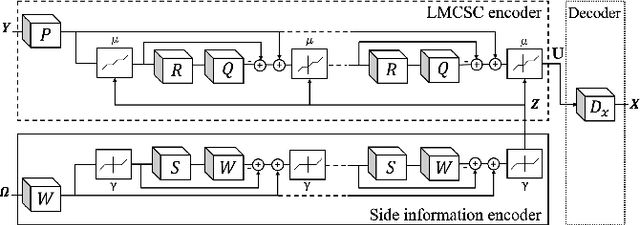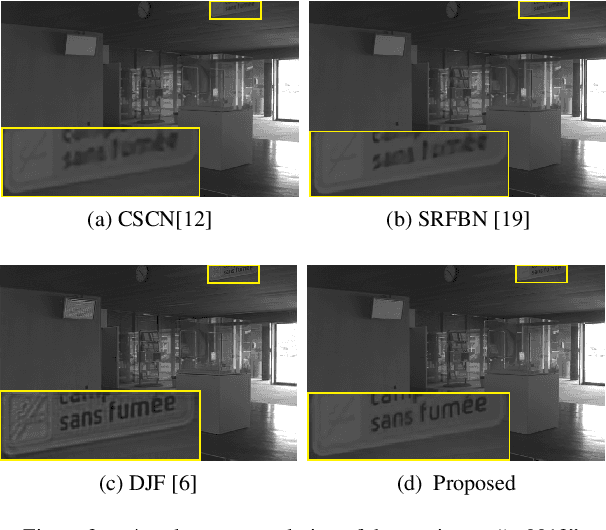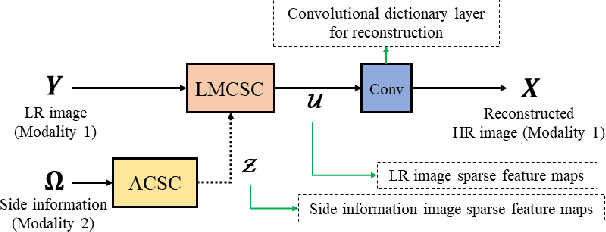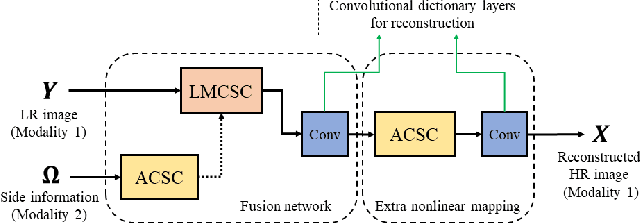Iman Marivani
Interpretable Deep Multimodal Image Super-Resolution
Sep 07, 2020


Abstract:Multimodal image super-resolution (SR) is the reconstruction of a high resolution image given a low-resolution observation with the aid of another image modality. While existing deep multimodal models do not incorporate domain knowledge about image SR, we present a multimodal deep network design that integrates coupled sparse priors and allows the effective fusion of information from another modality into the reconstruction process. Our method is inspired by a novel iterative algorithm for coupled convolutional sparse coding, resulting in an interpretable network by design. We apply our model to the super-resolution of near-infrared image guided by RGB images. Experimental results show that our model outperforms state-of-the-art methods.
Multimodal Deep Unfolding for Guided Image Super-Resolution
Jan 21, 2020



Abstract:The reconstruction of a high resolution image given a low resolution observation is an ill-posed inverse problem in imaging. Deep learning methods rely on training data to learn an end-to-end mapping from a low-resolution input to a high-resolution output. Unlike existing deep multimodal models that do not incorporate domain knowledge about the problem, we propose a multimodal deep learning design that incorporates sparse priors and allows the effective integration of information from another image modality into the network architecture. Our solution relies on a novel deep unfolding operator, performing steps similar to an iterative algorithm for convolutional sparse coding with side information; therefore, the proposed neural network is interpretable by design. The deep unfolding architecture is used as a core component of a multimodal framework for guided image super-resolution. An alternative multimodal design is investigated by employing residual learning to improve the training efficiency. The presented multimodal approach is applied to super-resolution of near-infrared and multi-spectral images as well as depth upsampling using RGB images as side information. Experimental results show that our model outperforms state-of-the-art methods.
Multimodal Image Super-resolution via Deep Unfolding with Side Information
Oct 18, 2019



Abstract:Deep learning methods have been successfully applied to various computer vision tasks. However, existing neural network architectures do not per se incorporate domain knowledge about the addressed problem, thus, understanding what the model has learned is an open research topic. In this paper, we rely on the unfolding of an iterative algorithm for sparse approximation with side information, and design a deep learning architecture for multimodal image super-resolution that incorporates sparse priors and effectively utilizes information from another image modality. We develop two deep models performing reconstruction of a high-resolution image of a target image modality from its low-resolution variant with the aid of a high-resolution image from a second modality. We apply the proposed models to super-resolve near-infrared images using as side information high-resolution RGB\ images. Experimental results demonstrate the superior performance of the proposed models against state-of-the-art methods including unimodal and multimodal approaches.
 Add to Chrome
Add to Chrome Add to Firefox
Add to Firefox Add to Edge
Add to Edge